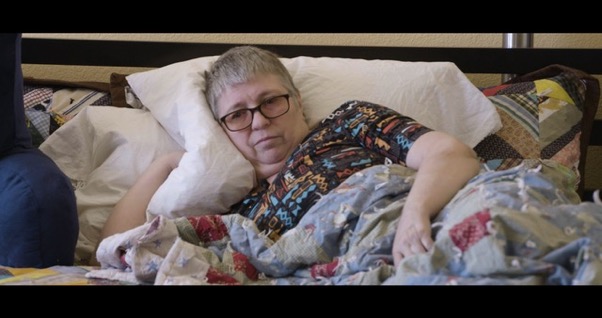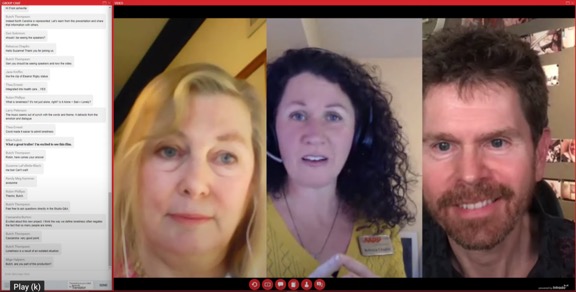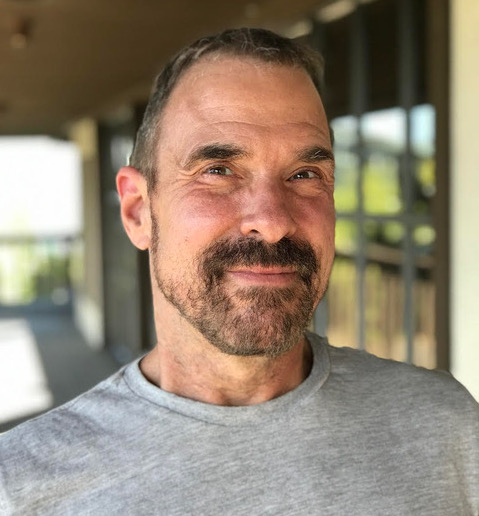THE DISTRIBUTION BULLETIN ISSUE #47
- A Crash Course -
By Peter Broderick & Keith Ochwat
Tired of waiting months, years, or forever to begin earning money from your films?
You can now start making money before picture lock!
Most filmmakers struggle to cover continuing and seemingly endless costs: pre-production, production, post, festivals, delivery, and marketing. The wait for meaningful revenues is long or very long.
Joe Applebaum and Stu Maddux are pioneering a bold new strategy to fast-forward revenues. They have discovered three ways to make money while making their films.
CRASH COURSE
Joe and Stu generated over $250,000 in revenues while they were making their latest film, ALL THE LONELY PEOPLE. They revealed how they did it to Keith and me during a recent Show&Tell webinar. We also did a series of interviews with them to learn the key lessons to share with you in this Bulletin.
Andrea Richie is bed bound. She opened up about her struggle
with isolation in ALL THE LONELY PEOPLE
Stu and Joe believe there should be “no secrets” among independent filmmakers. They are committed to being open and transparent about their methods and their revenues, confident it will be helpful to other independents.
Keith and I have created this mini-crash course to empower you to fast forward revenues.
It includes three written modules:
- How to create a powerful clip presentation during production
- How to secure corporate and nonprofit partners early
- How to partner with government agencies before picture lock
This crash course also includes three webinars:
- READY FOR LAUNCH: 6 ESSENTIAL STEPS TO PERFECT YOUR DISTRIBUTION STRATEGY - We explain the revolutionary concept of pre-distribution and show how to use it to maximize your distribution
- CUTTING EDGE FUNDRAISING - HOW TO START MAKING MONEY BEFORE PICTURE LOCK - A candid conversation with Joe and Stu about fast-forwarding revenues for ALL THE LONELY PEOPLE
- ALL THE LONELY PEOPLE: A DISCUSSION ABOUT CHRONIC LONELINESS AND ISOLATION - Stu and Joe’s model clip presentation presented by AARP North Carolina
How to Create a Powerful Clip Presentation During Production

AARP ALL THE LONELY PEOPLE presentation. From left to right: Val Walker (Author – Consultant – Educator); Rebecca Chaplin (Associate State Director, AARP North Carolina Mountain Region); Stu Maddux (Director of "All The Lonely People")
Here are the key elements that made it work so well:
- It is personal. Stu begins by explaining why he was compelled to make the film. “I’m lonely. I’m aging. I’m worried about it.”
- It is well-structured. It highlights at the start the elements of the presentation viewers won’t want to miss so they will keep watching.
- A teaser previews the future film.
- An excellent host and a knowledgeable expert complement Stu and make for a dynamic threesome.
- Moving clips show how people around the world are faring during this epidemic of loneliness.
- The event is very interactive. Audience members are invited to ask questions, make comments in the chat, participate in polls, and take the Loneliness Quiz.
- The Loneliness Quiz is irresistible. Viewers grade themselves and share their results, as the hosts compare their scores.
- Feedback is solicited. Stu invites the audience to be part of shaping the film. Stu and Joe valued these events as focus groups with strangers. They learned which characters viewers responded to the most and which story lines weren’t working.
- The event has personal utility for lonely and isolated viewers. They learn from the insights and tips provided by Stu and his co-presenters. The presentation highlights the “caravan of support” and resources available to viewers.
- Empathy The overall tone was warm, caring, and understanding. Viewers are not lectured at, condescended to, or persuaded to buy anything.
These 13 presentations netted $42,700 before picture lock.
They fast-forwarded the arrival of the film’s first meaningful revenues by 1 or 2 years.
The presentations also greatly increased the value of the money by making it available when it could defray the costs of making the film rather than years later, long after the film was finished.
As valuable as these initial revenues were, the ultimate impacts of the presentations were far greater.
THE PRESENTATIONS OPENED DOORS TO MORE REVENUE
The presentations raised critical awareness within target audiences and enabled Joe and Stu to build powerful partnerships. These partnerships propelled them to receive commitments of over $250,000 in support for their film—all before picture lock.
Partners ranged from large healthcare companies to senior living facilities to government agencies. All shared an appreciation for the message of ALL THE LONELY PEOPLE.
The presentations demonstrated to the partners how useful the film will be in their work with customers and communities.
They made clear that:
- the subjects of loneliness and isolation were attracting large audiences
- Stu and Joe’s clips captured these subjects effectively
- viewers were engaged and kept watching
- viewers found the presentations hopeful and helpful
Unlike hard to evaluate written proposals for films yet to be made, the presentations made real the value and potential impact of ALL THE LONELY PEOPLE even though it was unfinished.
How to Secure Corporate and Nonprofit Partners Early
You don’t need a finished film to start building relationships that can provide the support you need. Joe and Stu started building awareness of their film and pursuing partnerships almost two years before picture lock. 
Joe Applebaum (Producer of "All The Lonely People") Credit: Stu Maddux
They began proactively reaching out directly to potential partners. Their successful presentations generated word-of-mouth and possible partners started approaching them.
The presentations also illustrate a key factor that few filmmakers understand. Most potential partners in the corporate, philanthropic, and public sectors can make better use of shorter material than a feature length film. They can do much more with a 15-minute version of a feature, a short, a series of clips, or a spot. They can be used as part of a conference keynote, presented during a webinar, shown on television, or spread online.
In addition to video content, many partners want an experience, like a presentation or Q&A (live or virtual), that adds complementary insights and value. Joe and Stu learned this first-hand as they booked events months before locking their film. By integrating their clips in an interactive presentation, Joe and Stu demonstrated how their partners can have the greatest impact with their material. Potential partners became partners after attending live presentations and being wowed.
Here are nine essential steps to secure corporate and nonprofit partners:
Identify the right partners
- Create a hit list of potential partners. This list should be large and include companies, nonprofits, foundations, and advocacy groups
- Prioritize partners with a clear track record of supporting communities, causes, issues, conferences, or legislative advocacy related to your film’s message
- Track down the names, phone numbers, and email addresses of potential partners by using tools like LinkedIn and RocketReach, with a focus on staff working in marketing and communications
Emphasize your alignment and share short clips
- Email your leads and be prepared to practice polite persistence because most unsolicited emails go unanswered
- Speak on the phone with a few of your prioritized partners to make clear why you think your film is relevant to their work and understand how your film can be useful to them
- Share a simple pitch deck (just a couple of pages, short and sweet!) and either your trailer or clips from your film. No need to share your film at this stage. If they ask for it, let them know when you expect the full cut will be done
Host an event together and start the ripple effect
- Offer to host a work-in-progress virtual event with a presentation and ask for a fee. Position it as a fun community engagement event, joint fundraising event, or training session for employees
- Host events to spread the word about your film, which will lead to more opportunities
- Collect email addresses from attendees (some of whom may want to host their own events) and a glowing quote from your partner to use in future outreach
Joe and Stu secured a partnership with the healthcare company Humana months before picture lock. Humana had learned about ALL THE LONELY PEOPLE after attending one of Joe and Stu’s presentations and expressed interest in working together. The film complements Humana’s existing Loneliness & Social Isolation programming. Joe and Stu pitched Humana on sponsoring a series of 11 virtual events focused on cities the company had prioritized for community engagement. Humana is paying $20,000 for 3 initial events and will pay an additional fee for another 8 planned events.
How to Partner with Government Agencies Before Picture Lock
Government agencies are partnering with documentary filmmakers more frequently. Previously many independents thought the only government agencies that supported film were the National Endowment of the Arts and National Endowment of the Humanities. Today more and more filmmakers are securing partnerships leading to significant funding and promotion from a variety of local, state, and federal agencies, as well as court systems and Governor’s offices.
Here are three essential steps to effectively pitch government agencies:
Find the right agencies to target
- Get started by thinking about what your film is about, what issues are at its core, and then identify parts of the government that are involved in those issues
- If your film is about international issues, reach out to the State Department
- If your film is about sustainable farming, reach out to the Department of Agriculture or a local office of the USDA
- If your film is about domestic violence, reach out to the public information officer of your local Family Court
Align your film with agency’s needs
- It can be included in their internal training content for employees
- It can be used to engage their constituents and communities they serve
- Clips from your film can be included in their website and social media
Get your foot in the door with the right person
- Start with public information and community engagement offices
- Begin locally and then move up to the state and national levels
- Introduce yourself and your film. Don't worry if you're not sure exactly what to pitch. Sometimes by just getting on their radar will spark good ideas and promising opportunities
During post, Joe and Stu reached out to state social services departments in California and New York. The agencies determined that the film will be a valuable tool in their efforts to combat loneliness.
The California Department of Social Services paid $30,000 to license a five-minute clip of ALL THE LONELY PEOPLE that they will put on their website. Stu and Joe also agreed to create additional content for the Department—the beginning of a continuing partnership.
The New York State Department of Aging paid $60,000 for 15 screenings of ALL THE LONELY PEOPLE. The Department is also interested in doing 15 additional screenings next spring for an additional $60,000.
THE BENEFITS
What began simply with a request from a conference to show something of the film they were making ended up transforming its distribution opportunities.
The extremely effective clip presentation Joe and Stu created enabled them to:
- fast forward immediate and future revenues
- attract potential partners and build solid partnerships with them
- gain valuable feedback that helped them make a better film
- test core audiences to learn which ones to focus on
- refine their pitch and positioning of the film
- provide helpful insights to viewers struggling with loneliness
- create positive awareness among viewers and more potential partners
We strongly recommend you watch these two invaluable webinars.
- CUTTING EDGE FUNDRAISING - HOW TO START MAKING MONEY BEFORE PICTURE LOCK - Joe and Stu reveal how they fast-forwarded revenues for ALL THE LONELY PEOPLE
- READY FOR LAUNCH: 6 ESSENTIAL STEPS TO PERFECT YOUR DISTRIBUTION STRATEGY - We explain the revolutionary concept of pre-distribution and show how to use it to maximize your distribution
They will empower and inspire you!
© 2022 Peter Broderick